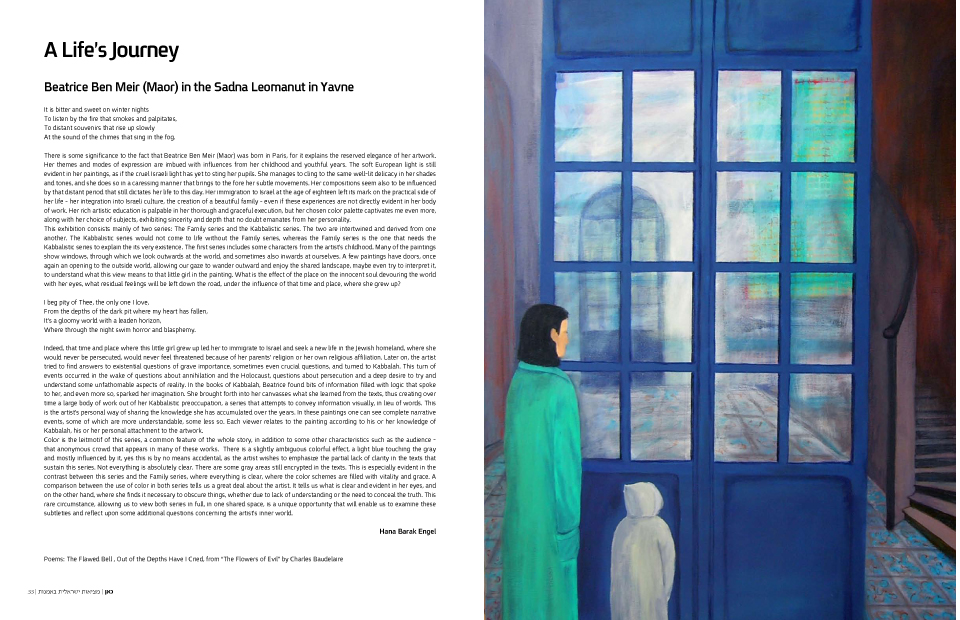
| Home Page | Editor Notices | Museums | Galleries | Publication | Donation | Contact Us |


 | |||||||||||||||
| |||||||||||||||


| |||||||||||||||
| A Life’s Journey / Beatrice Ben Meir (Maor) in the Sadna Leomanut in Yavne |
It is bitter and sweet on winter nights To listen by the fire that smokes and palpitates, To distant souvenirs that rise up slowly At the sound of the chimes that sing in the fog. There is some significance to the fact that Beatrice Ben Meir (Maor) was born in Paris, for it explains the reserved elegance of her artwork. Her themes and modes of expression are imbued with influences from her childhood and youthful years. The soft European light is still evident in her paintings, as if the cruel Israeli light has yet to sting her pupils. She manages to cling to the same well-lit delicacy in her shades and tones, and she does so in a caressing manner that brings to the fore her subtle movements. Her compositions seem also to be influenced by that distant period that still dictates her life to this day. Her immigration to Israel at the age of eighteen left its mark on the practical side of her life - her integration into Israeli culture, the creation of a beautiful family - even if these experiences are not directly evident in her body of work. Her rich artistic education is palpable in her thorough and graceful execution, but her chosen color palette captivates me even more, along with her choice of subjects, exhibiting sincerity and depth that no doubt emanates from her personality. This exhibition consists mainly of two series: The Family series and the Kabbalistic series. The two are intertwined and derived from one another. The Kabbalistic series would not come to life without the Family series, whereas the Family series is the one that needs the Kabbalistic series to explain the its very existence. The first series includes some characters from the artist’s childhood. Many of the paintings show windows, through which we look outwards at the world, and sometimes also inwards at ourselves. A few paintings have doors, once again an opening to the outside world, allowing our gaze to wander outward and enjoy the shared landscape, maybe even try to interpret it, to understand what this view means to that little girl in the painting. What is the effect of the place on the innocent soul devouring the world with her eyes, what residual feelings will be left down the road, under the influence of that time and place, where she grew up? I beg pity of Thee, the only one I love, From the depths of the dark pit where my heart has fallen, It's a gloomy world with a leaden horizon, Where through the night swim horror and blasphemy. Indeed, that time and place where this little girl grew up led her to immigrate to Israel and seek a new life in the Jewish homeland, where she would never be persecuted, would never feel threatened because of her parents' religion or her own religious affiliation. Later on, the artist tried to find answers to existential questions of grave importance, sometimes even crucial questions, and turned to Kabbalah. This turn of events occurred in the wake of questions about annihilation and the Holocaust, questions about persecution and a deep desire to try and understand some unfathomable aspects of reality. In the books of Kabbalah, Beatrice found bits of information filled with logic that spoke to her, and even more so, sparked her imagination. She brought forth into her canvasses what she learned from the texts, thus creating over time a large body of work out of her Kabbalistic preoccupation, a series that attempts to convey information visually, in lieu of words. This is the artist's personal way of sharing the knowledge she has accumulated over the years. In these paintings one can see complete narrative events, some of which are more understandable, some less so. Each viewer relates to the painting according to his or her knowledge of Kabbalah, his or her personal attachment to the artwork. Color is the leitmotif of this series, a common feature of the whole story, in addition to some other characteristics such as the audience - that anonymous crowd that appears in many of these works. There is a slightly ambiguous colorful effect, a light blue touching the gray and mostly influenced by it, yes this is by no means accidental, as the artist wishes to emphasize the partial lack of clarity in the texts that sustain this series. Not everything is absolutely clear. There are some gray areas still encrypted in the texts. This is especially evident in the contrast between this series and the Family series, where everything is clear, where the color schemes are filled with vitality and grace. A comparison between the use of color in both series tells us a great deal about the artist. It tells us what is clear and evident in her eyes, and on the other hand, where she finds it necessary to obscure things, whether due to lack of understanding or the need to conceal the truth. This rare circumstance, allowing us to view both series in full, in one shared space, is a unique opportunity that will enable us to examine these subtleties and reflect upon some additional questions concerning the artist’s inner world. Hana Barak Engel Poems: The Flawed Bell , Out of the Depths Have I Cried, from “The Flowers of Evil” by Charles Baudelaire Read more  |
| all rights reserved - CAN ISRAELI ART REALITY |
| סייבורג מחשבים - בניית אתרים |